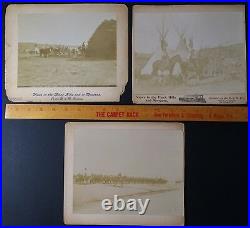

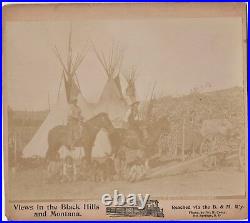
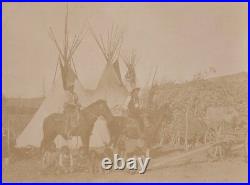
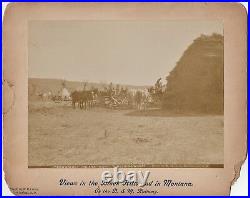
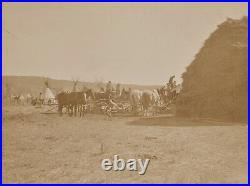


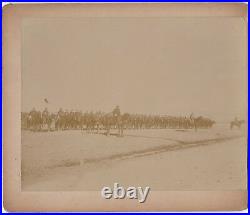
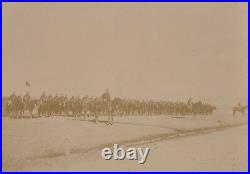

RARE Old Photo Archive. Crow Agency Indians, Montana. Black Hills – Montana. For offer – a very interesting photo grouping! Fresh from an estate in Upstate Western NY. Never offered on the market until now. Vintage, Old, antique, Original – NOT a Reproduction – Guaranteed!! Photographer imprint of W. Cross, Hot Springs, South Dakota. At bottom of photos: Views in the Black Hills and Montana, reached via the B & M Railway. This text slightly varied on one of the otos. Nice logo of steam train locomotive. 4 photos – one of them is two-sided (three pieces) – see photos for details. With back matte, each measures just under 8 x 10 inches. Images show Crow Agency Indians Threshing wheat, group of Indians and children, group of soldiers, and old men / soldiers in front of building. Overall, in good condition. Photos are somewhat faded, as shown. Chipping to matte edges. If you collect photography, 19th century era American history, Americana, Culture / ethnicity, etc. This is a nice one for your paper or ephemera collection. Crow Agency is a census-designated place (CDP) in Big Horn County, Montana, United States and is near the actual location for the Little Bighorn National Monument and re-enactment produced by the Real Bird family known as Battle of the Little Bighorn Reenactment. The population was 1,616 at the 2010 census. It is the governmental headquarters of the Crow Native Americans. [1] It is also the location of the “agency offices” where the federal Superintendent of the Crow Indian Reservation and his staff (part of the Bureau of Indian Affairs, United States Department of the Interior) interacts with the Crow Tribe, pursuant to federal treaties and statutes. The ending scenes in the film Little Big Man (1970) were filmed in Crow Agency. History of the three locations of the “Crow Agency”[edit]. The term “Crow Agency” has been historically used since 1868 for the headquarters where the United States directed the federal interaction with the Crow tribe on its reservation. The Crow Tribe’s reservations, and the tribe’s relations to the United States were defined by treaties between the Crow Tribe and the United States, and by United States statutes. The Treaty of Fort Laramie of 1851 created extensive reservation lands for the Indian tribes in Montana, Wyoming and the Dakotas at a time when the non-Indian presence in this area was limited to roving traders. A large reservation for the Crow Tribe was set out that was centered on the Big Horn Mountains and extended eastward into the Powder River basin to the banks of the Powder River. [4] However, this treaty did not indicate agency sites for any of the tribes, including the Crows. [5] At the time of the treaty, 1851 the Crow tribe consisted of nomadic bands whose culture was based on hunting the migratory buffalo herds, including those herds in the Powder River Country. Hunting in the Powder River area on the east side of the Big Horn Mountains brought the Crow in increasing conflict with more powerful bands of Sioux who were migrating westward. In 1863 gold was discovered in commercial quantities in the mountains of the western Montana Territory. Travelers to the gold fields left the Oregon Trail and traveled through the Powder River country, going up the east side of the Big Horns to the Yellowstone valley, and then westward. This route became known as the Bozeman Trail, and three forts were built to protect travelers. The Sioux conducted an all out war against the forts and the travelers on the Bozeman Trail called “Red Cloud’s War”, which finally forced the United States to agree to abandon the forts, and close the trail, and to remake the boundaries of the reservations for the Crow and Sioux in the Fort Laramie Treaty of 1868. The Fort Laramie “Treaty with the Crows, 1868″, [6] was one of a series of treaties that recognized the encroaching presence of the Sioux tribes into the Powder River Basin, and gave them that entire area as a hunting preserve. [7] The separate 1868 treaty with the Crow moved the center of the Crow lands to the west of the Powder River Basin, into the western portions of the Yellowstone Valley. The 1868 Treaty provided for annuities and other federal support, and stipulated that the Crow would have an agency “on the south side of the Yellowstone, near Otter Creek”, close to present day Big Timber, Montana. [8] This first Crow Agency was located in the western reaches of the Yellowstone River Valley, north of the Absaroka Range of Mountains. The Crows continued a largely nomadic life style hunting on the buffalo ranges to the east, though this brought them in constant but sporadic conflict with the Sioux who dominated the Powder River area. Landforms near Crow Agency, Montana. In 1874 miners encroached on the western margins of Crow lands in the Absaroka Range, and the reservation was reduced in 1875. The first Crow Agency was within these ceded lands and so the Agency was relocated eastward to a new site north of modern-day Absarokee, Montana. The 9-year period from 1875 to 1884 was a time of rapid transition on the plains of eastern Montana and Wyoming. In 1876 the Crows provided scouts for the United States military forces in the Great Sioux War of 1876. The defeat by the Sioux of George Armstrong Custer at the Battle of the Little Big Horn in 1876 resulted in a concerted military backlash against the Sioux, and by 1877 and 1878 the hostile bands of Sioux had either fled to Canada, or they had surrendered and were confined to reservations along the Missouri River in the Dakotas. This initially left the Crows more secure in their use of the buffalo ranges on the eastern Montana and Wyoming plains, but in 1876 and 1877 federal forts were built across this area. With hostile Indian presence essentially neutralized, hide hunters came to harvest the northern buffalo herds. By 1882 the buffalo were gone from this area. Also, in 1880 the Northern Pacific Railroad began building eastward from Bismark, ND, and in 1882 they completed their northern transcontinental line, which passed up the Yellowstone River valley just as the last of the buffalo disappeared. Almost at once large Texas trail herds arrived in the Montana Territory to exploit the now empty open range on the vast plains of central and eastern Montana. These successive rapid changes in this 9-year period eliminated the herds of bison and reduced other wild game on which the Crow culture relied, and ended forever the Crow’s nomadic way of life. The Third Crow Agency (1884 to Present)[edit]. In 1884 these events led to the last movement of the Crow Agency to the site of its third and final location at present day Crow Agency, Montana, 60 miles SE of Billings on the Little Bighorn River. This move of over a hundred miles eastward removed the Crow people from the vicinity of the Absaroka Range of Mountains, and from the Yellowstone River valley, and placed their reservation center on the east side of the Big Horn Mountains, on the western edge of the Powder River Basin of the northern great plains. As of the census[9] of 2000, there were 1,552 people, 336 households, and 303 families residing in the CDP. The population density was 213.3 people per square mile (82.3/km²). There were 361 housing units at an average density of 49.6 per square mile (19.1/km²). The racial makeup of the CDP was 3.74% White, 95.68% Native American, 0.06% Asian, and 0.52% from two or more races. Hispanic or Latino of any race were 1.16% of the population. There were 336 households out of which 52.4% had children under the age of 18 living with them, 55.4% were married couples living together, 26.5% had a female householder with no husband present, and 9.8% were non-families. 7.4% of all households were made up of individuals and 0.6% had someone living alone who was 65 years of age or older. The average household size was 4.40 and the average family size was 4.66. In the CDP, the population was spread out with 41.5% under the age of 18, 10.6% from 18 to 24, 25.5% from 25 to 44, 17.8% from 45 to 64, and 4.6% who were 65 years of age or older. The median age was 23 years. For every 100 females there were 96.5 males. For every 100 females age 18 and over, there were 89.2 males. About 39.6% of families and 40.9% of the population were below the poverty line, including 42.6% of those under age 18 and none of those age 65 or over. Today the Crow Tribe, also known as the Crow Nation, administers many of their own affairs through their constitutionally based tribal government. The town of Crow Agency is the headquarters of the Crow Tribal Administration, the Crow Tribal Courts, the Legislature of the Crow Nation. It also remains the site of the local office of the U. Bureau of Indian Affairs, which deals with the Crow Tribe, and its affairs and the related Crow tribal lands. The Annual Crow Fair, which is held every third weekend in August, is held on this reservation. The Crow Fair is known as “The Teepee Capital of the World, ” by the fact that during celebration as many as 1,500 teepees are seen across the river valley of the Little Big Horn River. The PBS series Reading Rainbow filmed its tenth episode “The Gift of the Sacred Dog” here on June 17, 1983. The title was based on a book by Paul Goble and was narrated by actor Michael Ansara. Tuff Harris, Pittsburgh Steelers safety, was born here. Clara Nomee, former Chairwoman of the Crow Nation, was born here. Jonathan Maxwell Beartusk, Solar Artist, was born here. Big Horn County is a county in the U. As of the 2010 census, the population was 12,865. [1] The county seat is Hardin. [2] The county, like the river and mountain range, were named for the bighorn sheep in the Rocky Mountains. [3] The county was founded in 1913. [4] It is immediately to the north from the northern Wyoming state line. Law and government[edit]. The county has several jurisdictions, each with its own regulations and law enforcement agencies. The Crow and Northern Cheyenne Indian Nations are administered by the tribes. Little Bighorn Battlefield and the Big Horn Canyon National Recreation Area are regulated by the National Park Service. The remainder of the county falls under the State of Montana. The Burlington and Missouri River Railroad (B&MR) was an American railroad company incorporated in Iowa in 1852, with headquarters in Omaha, Nebraska. It was developed to build a railroad across the state of Iowa and began operations in 1856. It was acquired by the Chicago, Burlington and Quincy Railroad in 1872, and kept serving as its subsidiary. The first train to arrive in Broken Bow, Nebraska, August 26, 1886. B&MR Stock certificate, cancelled 1872. Map showing connections to harbors via the Burlington and Missouri River Railroad, 1888. The Burlington and Missouri River Railroad was incorporated in Burlington, Iowa in 1852. It commenced operations on January 1, 1856 with only a few miles of track. In 1857 it connected to Ottumwa, followed by Murray in 1858. It finally reached the Missouri River in November 1859. It used wood-burning locomotives and wooden passenger cars. After the Chicago, Burlington and Quincy Railroad (CB&Q) finished a bridge crossing the Mississippi River at Burlington, it connected to the Burlington and Missouri River Railroad. A sub-branch of the railroad was founded in Nebraska in 1869, [1] with rails first entering the state in 1870 via Plattsmouth. [3] That summer, the railroad reached Lincoln, the recently designated state capital. [1] It later continued to lay rails westward and eventually joining with the Union Pacific Railroad on September 3, 1872 at Kearney; this had the effect of linking traffic from southern Nebraska to the rest of the continent. [3] That same year it began advertising “millions of acres of cheap land” as an incentive to prospective settlers to Iowa and Nebraska. The Burlington and Missouri River Railroad was acquired by the Chicago, Burlington and Quincy Railroad in 1872. At the time, it had begun laying tracks to Denver, Colorado; this line was finished by the CB&Q ten years later. After being acquired by the Chicago, Burlington and Quincy Railroad, the Burlington and Missouri River Railroad served as its subsidiary, operating several lines in the Black Hills, including those acquired when Chicago, Burlington and Quincy Railroad took over the Black Hills and Fort Pierre Railroad in 1901. The Crow, called the Apsáalooke in their own Siouan language, or variants including the Absaroka, are Native Americans, who in historical times lived in the Yellowstone River valley, which extends from present-day Wyoming, through Montana and into North Dakota, where it joins the Missouri River. In the 21st century, the Crow people are a Federally recognized tribe known as the Crow Tribe of Montana, [1] and have a reservation located in the south central part of the state. Pressured by the Ojibwe and Cree peoples (the Iron Confederacy), who had earlier and better access to guns through the fur trade, the Crow had migrated to this area from the Ohio Eastern Woodland area of present-day Ohio, settling south of Lake Winnipeg. From there, they were pushed to the west by the Cheyenne. Both the Crow and the Cheyenne were pushed farther west by the Lakota (Sioux), who took over the territory west of the Missouri River, reaching past the Black Hills of South Dakota to the Big Horn Mountains of Wyoming and Montana. The Cheyenne eventually became allies of the Lakota, as they sought to expel European Americans from the area. The Crow remained bitter enemies of both the Sioux and Cheyenne. The Crow were generally friendly with the whites and managed to retain a large reservation of more than 9300 km2 despite territorial losses. Since the 19th century, Crow people have been concentrated on their reservation established south of Billings, Montana. They also live in several major, mainly western, cities. Tribal headquarters are located at Crow Agency, Montana. The name of the tribe, Apsáalooke [psáòè], meaning “children of the large-beaked bird, “[3] was given to them by the Hidatsa, a neighboring Siouan-speaking tribe. French interpreters translated the name as gens du corbeaux (“people of [the] crows”), and they became known in English as the Crow. Other tribes also refer to the Apsáalooke as “crow” or “raven” in their own languages. In 1743 the Absaroka encountered their first people of European descent, the two La Vérendrye brothers from New France (eastern Canada). The explorers called the Apsáalooke beaux hommes (handsome men). The Crow called the French explorers baashchíile (persons with yellow eyes). In the Northern Plains[edit]. The early home of the Crow-Hidatsa ancestral tribe was in the Ohio country, near Lake Erie. Driven from there by better armed, aggressive neighbors, they settled for a while south of Lake Winnipeg in Manitoba. [5][page needed] Later the people moved to the Devil’s Lake region of North Dakota before the Crow split from the Hidatsa and moved westward. The Crow were largely pushed westward due to intrusion and influx of the Cheyenne and subsequently the Sioux, also known as the Lakota. To acquire control of their new territory, they warred against Shoshone bands (called Bikkaashe”People of the Grass Lodges”), [6] and drove them westward. They allied with local Kiowa and Kiowa Apache bands. [7][8][9] The Kiowa and Kiowa Apache bands later migrated southward, and the Crow remained dominant in their established area through the 18th and 19th centuries, the era of the fur trade. Their tribal territory stretched from what is now Yellowstone National Park and the headwaters of the Yellowstone River (E-chee-dick-karsh-ah-shay”Elk River”) in the west, north to the Musselshell River, then northeast to the Yellowstone’s mouth at the Missouri River, then southeast to the confluence of the Yellowstone and Powder rivers (Bilap chashee”Powder River” or “Ash River”), south along the South Fork of the Powder River, confined in the SE by the Rattlesnake Mountains and westwards in the SW by the Wind River Range. Their tribal area included the river valleys of the Judith River (Buluhpa’ashe”Plum River”), Powder River, Tongue River, Big Horn River and Wind River as well as the Bighorn Mountains (Iisiaxpúatachee Isawaxaawúua), Pryor Mountains (Baahpuuo Isawaxaawúua), Wolf Mountains (Cheetiish”Wolf Teeth Mountains”) and Absaroka Range (also called Absalaga Mountains). Once established in the Valley of the Yellowstone River[11] and its tributaries on the Northern Plains in Montana and Wyoming, the Crow divided into four groups: the Mountain Crow, River Crow, Kicked in the Bellies, and Beaver Dries its Fur. Formerly semi-nomad hunters and farmers in the northeastern woodland, they adapted to the nomadic lifestyle of the Plains Indians as hunters and gatherers, and hunted bison. Before 1700, they were using dog travois for carrying goods. Enemies and allies[edit]. Ledger drawing of a Cheyenne war chief and warriors (left) coming to a truce with a Crow war chief and warriors (right). A scout on a horse, 1908 by Edward S. From about 1740, the Plains tribes rapidly adopted the horse, which allowed them to move out on to the Plains and hunt buffalo more effectively. However, the severe winters in the North kept their herds smaller than those of Plains tribes in the South. The Crow, Hidatsa, Eastern Shoshone and Northern Shoshone soon became noted as horse breeders and dealers, and developed relatively large horse herds. At the time, other eastern and northern tribes were also moving on to the Plains, in search of game for the fur trade, bison, and more horses. The Crow were subject to raids and horse thefts by horse-poor tribes, including the powerful Blackfoot Confederacy, Gros Ventre, Assiniboine, Pawnee, and Ute. [14][15] Later they had to face the Lakota and their allies, the Arapaho and Cheyenne, who also stole horses from their enemies. Their greatest enemies became the tribes of the Blackfoot Confederacy and the Lakota-Cheyenne-Arapaho alliance. The Crow were generally friendly with the northern Plains tribes of the Flathead (although sometimes they had conflicts); Nez Perce, Kutenai, Shoshone, Kiowa and Kiowa Apache. The powerful Iron Confederacy (Nehiyaw-Pwat), an alliance of northern plains Indian nations based around the fur trade, developed as enemies of the Crow. It was named after the dominating Plains Cree and Assiniboine peoples, and later included the Stoney, Saulteaux, Ojibwe, and Métis. The Apsaalooke by the early 19th century were divided into three independent groupings, who came together only for common defense:[16]. Ashalaho (Many Lodges, today called Mountain Crow), Awaxaawaxammilaxpáake (Mountain People), or Ashkúale (The Center Camp). The Ashalaho or Mountain Crow, the largest Crow group, split from the Awatixa Hidatsa and were the first to travel west. (Bowers 1992: 21) Their leader No Intestines had received a vision and led his band on a long migratory search for sacred tobacco, finally settling in southeastern Montana. They lived in the Rocky Mountains and foothills along the Upper Yellowstone River, on the present-day Wyoming-Montana border, in the Big Horn and Absaroka Range (also Absalaga Mountains); the Black Hills comprised the eastern edge of their territory. Binnéessiippeele (Those Who Live Amongst the River Banks), today called River Crow or Ashshipíte (The Black Lodges) The Binnéessiippeele, or River Crow, split from the Hidatsa proper, according to tradition because of a dispute over a bison stomach. As a result, the Hidatsa called the Crow Gixáa-iccá”Those Who Pout Over Tripe”. [17][18] They lived along the Yellowstone and Musselshell rivers south of the Missouri River and in the river valleys of the Big Horn, Powder and Wind rivers. This area was historically known as the Powder River Country. They sometimes traveled north up to the Milk River. Eelalapito (Kicked In The Bellies) or Ammitaalasshé (Home Away From The Center, that is, away from the Ashkúale – Mountain Crow). [19][20] They claimed the area known as the Bighorn Basin, from the Bighorn Mountains in the east to the Absaroka Range to the west, and south to the Wind River Range in northern Wyoming. Sometimes they settled in the Owl Creek Mountains, Bridger Mountains and along the Sweetwater River in the south. The oral tradition of the Apsaalooke mentions a fourth group, the Bilapiluutche (Beaver Dries its Fur), who are believed to have merged with the Kiowa in the second half of the eighteenth century. Gradual displacement from tribal lands[edit]. Crow Indian territory (areas 517, 619 and 635) as described in Fort Laramie treaty (1851), present Montana and Wyoming. When European Americans arrived in numbers, the Crows were resisting pressure from enemies who greatly outnumbered them. In the 1850s, a vision by Plenty Coups, then a boy, but who later became their greatest chief, was interpreted by tribal elders as meaning that the whites would become dominant over the entire country, and that the Crow, if they were to retain any of their land, would need to remain on good terms with the whites. By 1851 the more numerous Lakota and Cheyenne were established just to the south and east of Crow territory in Montana. [23] These enemy tribes coveted the hunting lands of the Crow and warred against them. By right of conquest, they took over the eastern hunting lands of the Crow, including the Powder and Tongue River valleys, and pushed the less numerous Crow to the west and northwest upriver on the Yellowstone. After about 1860, the Lakota Sioux claimed all the former Crow lands from the Black Hills of South Dakota to the Big Horn Mountains of Montana. They demanded that the Americans deal with them regarding any intrusion into these areas. The Fort Laramie Treaty of 1851 with the United States confirmed as Crow lands a large area centered on the Big Horn Mountains: the area ran from the Big Horn Basin on the west, to the Musselshell River on the north, and east to the Powder River; it included the Tongue River basin. [24] But for two centuries the Cheyenne and many bands of Lakota Sioux had been steadily migrating westward across the plains, and were still pressing hard on the Crows. “Eight Crow prisoners under guard at Crow agency, Montana, 1887″. Red Cloud’s War (18661868) was a challenge by the Lakota Sioux to the United States military presence on the Bozeman Trail, a route along the eastern edge of the Big Horn Mountains to the Montana gold fields. Red Cloud’s War ended with victory for the Lakota Sioux. The Treaty of Fort Laramie (1868) with the United States confirmed the Lakota control over all the high plains from the Black Hills of the Dakotas westward across the Powder River Basin to the crest of the Big Horn Mountains. [25] Thereafter bands of Lakota Sioux led by Sitting Bull, Crazy Horse, Gall and others, along with their Northern Cheyenne allies, hunted and raided throughout the length and breadth of eastern Montana and northeastern Wyoming, which had been for a time ancestral Crow territory. On 25 June 1876, the Lakota Sioux and Cheyenne achieved a major victory over army forces under Colonel George A. Custer at the Battle of the Little Big Horn in the Crow Indian Reservation, [26] but the Great Sioux War (18761877) ended in the defeat of the Sioux and their Cheyenne allies. Crow warriors enlisted with the US Army for this war. The Sioux and allies were forced from eastern Montana and Wyoming: some bands fled to Canada, while others suffered forced removal to distant reservations, primarily in present-day Montana and Nebraska west of the Missouri River. In 1918, the Crow organized a gathering to display their culture, and they invited members of other tribes. The Crow Fair is now celebrated yearly on the third weekend of August, with wide participation from other tribes. Crow Indian history – a chronological record[edit]. They selected a site for a single earth lodge on the lower Yellowstone River. Most families lived in tipis or other perishable kinds of homes at the new place. These Indians had left the Hidatsa villages and adjacent cornfields for good, but they had yet to become “real” buffalo hunting Crows following the herds on the open plains. [28] Archaeologists know this “proto-Crow” site in present Montana as the Hagen site. Some time before 1765 the Crows held a Sun Dance, attended by a poor Arapaho. A Crow with power gave him a medicine doll, and he quickly earned status and owned horses as no one else. During the next Sun Dance, some Crows stole back the figure to keep it in the tribe. Eventually the Arapaho made a duplicate. Later in life, he married a Kiowa woman and brought the doll with him. The Kiowas use it during the Sun Dance and recognize it as one of the most powerful tribal medicines. They still credit the Crow tribe for the origin of their sacred Tai-may figure. The enmity between the Crow and the Lakota was reassured right from the start of the 19th Century. [31] The next year, the Lakotas and their Cheyenne allies killed all the men in a Crow camp with thirty tipis. In the summer of 1805, a Crow camp traded at the Hidatsa villages on Knife River in present North Dakota. Chiefs Red Calf and Spotted Crow allowed the fur trader Francois-Antoine Larocque to join it on its way across the plains to the Yellowstone area. He travelled with it to a point west of the place where Billings, Montana, is today. The camp crossed Little Missouri River and Bighorn River on the way. The next year, some Crows discovered a group of whites with horses on the Yellowstone River. By stealth, they captured the mounts before morning. The Lewis and Clark Expedition did not see the Crows. A Crow camp neutralized thirty Cheyennes bent on capturing horses in 1819. [36] The Cheyennes and warriors from a Lakota camp destroyed a whole Crow camp at Tongue River the following year. [37] This was likely the most severe attack on a Crow camp in historic time. The Crows put up 300 tipis near a Mandan village on the Missouri in 1825. [40] The representatives of the US government waited for them. Mountain Crow chief Long Hair (Red Plume at Forehead) and fifteen other Crows signed the first treaty of friendship and trade between the Crows and the United States on August 4. [41] With the signing of the document, the Crows also recognized the supremacy of the United States, if they actually understood the word. River Crow chief Arapooish had left the treaty area in disgust. By help of the thunderbird he had to send a farewell shower down on the whites and the Mountain Crows. In the summer of 1834, the Crows (maybe led by chief Arapooish) tried to shut down Fort McKenzie at the Missouri in Blackfeet country. The apparent motive was to stop the trading post’s sale to their Indian enemies. Although later described as a month long siege of the fort, [43] it lasted only two days. [44] The opponents exchanged a few shots and the men in the fort fired a canon, but no real harm came to anyone. The Crows left four days before the arrival of a Blackfeet band. The episode seems to be the worst armed conflict between the Crows and a group of whites until the Sword Bearer uprising in 1887. The death of chief Arapooish was recorded on September 17, 1834. The news reached Fort Clark at the Mandan village Mitutanka. Chardon wrote he “was Killed by Black feet”. The smallpox epidemic of 1837 spread along the Missouri and “had little impact” on the tribe according to one source. [46] The River Crows grew in number, when a group of Hidatsas joined them permanently to escape the scourge sweeping through the Hidatsa villages. The River Crows charged a moving Blackfeet camp near Judith Gap in 1845. Father De Smet mourned the destructive attack on the “petite Robe” band. [48] The Blackfeet chief Small Robe had been mortally wounded and many killed. De Smet worked out the number of women and children taken captive to 160. By and by and with a fur trader as intermediary, the Crows agreed to let 50 women return to their tribe. The Oath Apsaroke by Edward S. Curtis depicting Crow men giving a symbolic oath with a bison meat offering on an arrow. The main food source for the Crow was the American bison which was hunted in a variety of ways. Before the use of horses the bison were hunted on foot and required hunters to stalk close to the bison, often with a wolf-pelt disguise, then pursue the animals quickly on foot before killing them with arrows or lances. The horse allowed the Crow to hunt bison more easily as well as hunt more at one time. Riders would panic the herd into a stampede and shoot the targeted animals with arrows or bullets from horseback or lance them through the heart. In addition to bison the Crow also hunted bighorn sheep, mountain goats, deer, elk, bear, and other game. Buffalo meat was often roasted or boiled in a stew with prairie turnips. The rump, tongue, liver, heart, and kidneys all were considered delicacies. Dried bison meat was ground with fat and berries to make pemmican. [50] In addition to meat, wild edibles were gathered and eaten such as elderberries, wild turnip, and Saskatoon berries. The Crow often hunted bison by utilizing buffalo jumps. “Where Buffaloes are Driven Over Cliffs at Long Ridge” was a favorite spot for meat procurement by the Crow Indians for over a century, from 1700 to around 1870 when modern weapons were introduced. [51] The Crow used this place annually in the autumn, a place of multiple cliffs along a ridge that eventually sloped to the creek. Early in the morning the day of the jump a medicine man would stand on the edge of the upper cliff, facing up the ridge. He would take a pair of bison hindquarters and pointing the feet along the lines of stones he would sing his sacred songs and call upon the Great Spirit to make the operation a success. [51] After this invocation the medicine man would give the two head drivers a pouch of incense. [51] As the two head drivers and their helpers headed up the ridge and the long line of stones they would stop and burn incense on the ground repeating this process four times. [51] The ritual was intended to make the animals come to the line where the incense was burned, then bolt back to the ridge area. Habitation and transportation[edit]. Crow Lodge of Twenty-five Buffalo Skins, 183233 by George Catlin. Crow men trading on horseback. Three Crow men on their horses, Edward S. The traditional Crow shelter is the tipi or skin lodge made with bison hides stretched over wooden poles. The Crow are historically known to construct some of the largest tipis. Tipi poles were harvested from the lodgepole pine which acquired its name from its use as support for tipis. [52] Inside the tipi, mattresses and buffalo-hide seats were arranged around the edge, with a fireplace in the center. The smoke from the fire escaped through a hole or smoke-flap in the top of the tipi. At least one entrance hole with collapsible flap allowed entry into the tipi. Often hide paintings adorned the outside and inside of tipis with specific meanings attached to the images. Often specific tipi designs were unique to the individual owner, family, or society that resided in the tipi. Tipis are easily raised and collapsed and are lightweight, which is ideal for nomadic people like the Crow who move frequently and quickly. Once collapsed, the tipi poles are used to create a travois. Travois are a horse-pulled frame structure used by plains Indians to carry and pull belongings as well as small children. Many Crow families still own and use the tipi, especially when traveling. The annual Crow Fair has been described as the largest gathering of tipis in the world. The most widely used form of transportation used by the Crow was the horse. Horses were acquired through raiding and trading with other Plains nations. People of the northern plains like the Crow mostly got their horses from people from the southern plains such as the Comanche and Kiowa who originally got their horses from the Spanish and southwestern Indians such as the various Pueblo people. The Crow had large horse herds which were among the largest owned by Plains Indians; in 1914 they had approximately thirty to forty thousand head. By 1921 the number of mounts had dwindled to just one thousand. Like other plains people the horse was central to the Crow economy and were a highly valuable trade item and were frequently stolen from other tribes to gain wealth and prestige as a warrior. The horse allowed the Crow to become powerful and skilled mounted warriors, being able to perform daring maneuvers during battle including hanging underneath a galloping horse and shooting arrows by holding onto its mane. They also had many dogs; one source counted five to six hundred. Dogs were used as guards and pack animals to carry belongings and pull travois. The introduction of horses into Crow society allowed them to pull heavier loads faster, greatly reducing the number of dogs used as pack animals. Clothing and beadwork[edit]. Painting of Holds The Enemy, a Crow warrior with split horn headdress and beaded wool leggings by E. Hó-ra-tó-a, a Crow warrior with headdress, bison robe, and hair reaching the ground. Painted by George Catlin, Fort Union 1832. The Crow wore clothing distinguished by gender. Women wore dresses made of deer and buffalo hide, decorated with elk teeth or shells. They covered their legs with leggings during winter and their feet with moccasins. Crow women wore their hair in two braids. Male clothing usually consisted of a shirt, trimmed leggings with a belt, a long breechcloth, and moccasins. Robes made from the furred hide of a bison were often worn in winter. Leggings were either made of animal hide which the Crow made for themselves or made of wool which were highly valued trade items made specifically for Indians in Europe. Their hair was worn long, in some cases reaching the ground. [53] The Crow are famous for often wearing their hair in a pompadour which was often coloured white with paint. Crow men were notable for wearing two hair pipes made from beads on both sides of their hair. Men often wore their hair in two braids wrapped in the fur of beavers or otters. Bear grease was used to give shine to hair. Stuffed birds were often worn in the hair of warriors and medicine men. Like other plains Indians the Crow wore feathers from eagles, crows, owls, and other birds in their hair for symbolic reasons. The Crow wore a variety of headdresses including the famous eagle feather headdress, bison scalp headdress with horns and beaded rim, and split horn headdress. The split horn headdress is made from a single bison horn split in half and polished into two nearly identical horns which were attached to a leather cap and decorated with feathers and beadwork. Traditional clothing worn by the Crow is still worn today with varying degrees of regularity. The Crow People are well known for their intercut beadwork. They adorned basically every aspect of their lives with these beads, giving special attention to ceremonial and ornamental items. Their clothing, horses, cradles, ornamental and ceremonial gear, in addition to leather cases of all shapes, sizes and uses were decorated in beadwork. [54] They gave reverence to the animals they ate by using as much of it as they could. The leather for their clothing, robes and pouches were created from the skin of buffalo, deer and elk. The work was done by the tribeswomen, with some being considered experts and were often sought by the younger, less experienced women for design and symbolic advice. [55] The Crow are an innovative people and are credited with developing their own style of stitch-work for adhering beads. This stitch, which is contemporarily called the over-lay, is still also known as the “Crow Stitch”. [54] In their beadwork, geometric shapes were primarily used with triangles, diamonds and hour-glass structures being the most prevalent. A wide range of colors were utilized by the Crow, but blues and various shades of pink were the most dominantly used. To intensify or to draw out a certain color or shape, they would surround that figure or color in a white outline. The colors chosen were not just merely used to be aesthetically pleasing, but rather had a deeper symbolic meaning. Pinks represented the various shades of the rising sun with yellow being the East the origin of the sun’s arrival. [54] Blues are symbolic of the sky; red represented the setting sun or the West; green symbolizing mother earth, black the slaying of an enemy[55] and white representing clouds, rain or sleet. [54] Although most colors had a common symbolism, each piece’s symbolic significance was fairly subjective to its creator, especially when in reference to the individual shapes. One person’s triangle might symbolize a teepee, a spear head to a different individual or a range of mountains to yet another. Regardless of the individual significance of each piece, the Crow People give reverence to the land and sky with the symbolic references found in the various colors and shapes found on their ornamental gear and even clothing. Some of the clothing that the Crow People decorated with beads included robes, vests, pants, shirts, moccasins and various forms of celebratory and ceremonial gear. In addition to creating a connection with the land, from which they are a part, the various shapes and colors reflected one’s standing and achievements. For example, if a warrior were to slay, wound or disarm an enemy, he would return with a blackened face. [55] The black color would then be incorporated in the clothing of that man, most likely in his war attire. A beaded robe, which was often given to a bride to be, could take over a year to produce and was usually created by the bride’s mother-in-law or another female relative-in-law. These robes were often characterized by a series of parallel horizontal lines, usually consisting of light blue. The lines represented the young women’s new role as a wife and mother; also the new bride was encouraged to wear the robe at the next ceremonial gathering to symbolize her addition and welcoming to a new family. [54] In modern times the Crow still often decorate their clothing with intricate bead designs for powwow and everyday clothing. Gender and kinship system[edit]. The Crow had a matrilineal system. After marriage, the couple was matrilocal (the husband moved to the wife’s mother’s house upon marriage). Women held a significant role within the tribe. Crow kinship is a system used to describe and define family members. Identified by Lewis Henry Morgan in his 1871 work Systems of Consanguinity and Affinity of the Human Family, the Crow system is one of the six major types which he described: Eskimo, Hawaiian, Iroquois, Crow, Omaha, and Sudanese. Like other Plains tribes, the Crow historically had three defined gender roles: male, female and baté (trans female / “two-spirit”). [56][57][58][59] Osh-Tisch was a well-known Crow baté. The modern Crow Tribe Apsáalooke Nation[edit]. The Crow Indian Reservation in south-central Montana is a large reservation covering approximately 2,300,000 acres (9,300 km2) of land area, the fifth-largest Indian reservation in the United States. The reservation is primarily in Big Horn and Yellowstone counties with ceded lands in Rosebud, Carbon, and Treasure Counties. The Crow Indian Reservation’s eastern border is the 107th meridian line, except along the border line of the Northern Cheyenne Indian Reservation. The southern border is from the 107th meridian line west to the east bank of the Big Horn River. The line travels downstream to Bighorn Canyon National Recreation Area and west to the Pryor Mountains and north-easterly to Billings. The northern border travels east and through Hardin, Montana, to the 107th meridian line. The 2000 census reported a total population of 6,894 on reservation lands. Its largest community is Crow Agency. Flag of the Crow Nation. Prior to the 2001 Constitution, the Crow Nation was governed by a 1948 Constitution. The former constitution organized the tribe as a General Council (Tribal Council). The General Council in essence held the executive, legislative, and judicial powers of the government, and was composed of all enrolled members of the Crow Nation, provided that females were 18 years or older and males were 21 or older. The General Council was a direct democracy, comparable to that of ancient Athens. The Crow Nation, or Crow Tribe of Indians, established a three-branch government at a 2001 Council Meeting. The new government is known as the 2001 Constitution. The General Council remains the governing body of the tribe; however, the powers were distributed to a three-branch government. In theory, the General Council is still the governing body of the Crow Nation, yet in reality the General Council has not convened since the establishment of the 2001 Constitution. The Executive Branch has four officials. These officials are known as the Chairperson, Vice-Chairperson, Secretary, and Vice-Secretary. The Executive Branch officials are also the officials within the Crow Tribal General Council, which has not met since 15 July 2001. These officials established the 2001 Constitution. The Chairman is Darrin Old Coyote. The Legislative Branch consists of three members from each district on the Crow Indian Reservation. The Crow Indian Reservation is divided into six districts known as The Valley of the Chiefs, Reno, Black Lodge, Mighty Few, Big Horn, and Pryor Districts. The Valley of the Chiefs District is the largest district by population. The Judicial Branch consists of all courts established by the Crow Law and Order Code and in accordance with the 2001 Constitution. The Judicial Branch has jurisdiction over all matters defined in the Crow Law and Order Code. The Judicial Branch attempts to be a separate and distinct branch of government from the Legislative and Executive Branches of Crow Tribal Government. The Judicial Branch consists of an elected Chief Judge and two Associate Judges. The Crow Court of Appeals, similar to State Court of Appeals, receives all appeals from the lower courts. The Chief Judge of the Crow Nation is Julie Yarlott. According to the 1948 Constitution, Resolution 63-01 Please note; in a letter of communication from Phileo Nash, then Commissioner of Indian Affairs, to the B. Area Director, as stated in the letter and confirmed that 63-01 is an Ordinance in said letter all constitutional amendments must be voted on by secret ballot or referendum vote. In 2001, major actions were taken by the former Chairperson Birdinground without complying with those requirements. The quarterly council meeting on 15 July 2001 passed all resolutions by voice vote, including the measure to repeal the current constitution and approve a new constitution. Critics contend the new constitution is contrary to the spirit of the Crow Nation, as it provides authority for the US Bureau of Indian Affairs (BIA) to approve Crow legislation and decisions. The Crow people have guarded their sovereignty and Treaty Rights. The alleged New Constitution was not voted on to add it to the agenda of the Tribal Council. The former constitution mandated that constitutional changes be conducted by referendum vote, using the secret ballot election method and criteria. In addition, a constitutional change can only be conducted in a specially called election, which was never approved by council action for the 2001 Constitution. The agenda was not voted on or accepted at the council. The only vote taken at the council was whether to conduct the voting by voice vote or walking through the line. Critics say the Chairman ignored and suppressed attempts to discuss the Constitution. This council and constitutional change was never ratified by any subsequent council action. The Tribal Secretary, who was removed from office by the BirdinGround Administration, was the leader of the opposition. All activity occurred without his signature. When the opposition challenged, citing the violation of the Constitutional Process and the Right to Vote, the Birdinground Administration sought the approval of the United States Department of the Interior (USDOI), Bureau of Indian Affairs (BIA). The latter stated it could not interfere in an internal tribal affair. The federal court also ruled that the constitutional change was an internal tribal matter. Further information: Crow Tribal Administration. The seat of government and capital of the Crow Indian Reservation is Crow Agency, Montana. The Crow Nation has traditionally elected a chairperson of the Crow Tribal Council biennially; however, in 2001, the term of office was extended to four years. The previous chairperson was Carl Venne. The chairperson serves as chief executive officer, speaker of the council, and majority leader of the Crow Tribal Council. The constitutional changes of 2001 created a three-branch government. The chairperson serves as the head of the executive branch, which includes the offices of vice-chairperson, secretary, vice-secretary, and the tribal offices and departments of the Crow Tribal Administration. Notable chairs are Clara Nomee, Edison Real Bird, and Robert “Robie” Yellowtail. On 19 May 2008, Hartford and Mary Black Eagle of the Crow Nation adopted U. Senator (now President) Barack Obama into the tribe on the date of the first visit of a U. Presidential candidate to the nation. [60] Crow representatives also took part in President Obama’s inaugural parade. Joseph Medicine Crow was one of 16 people awarded the Presidential Medal of Freedom. During the United States federal government shutdown of 2013, the Crow Nation furloughed 316 employees and suspended programs providing health care, bus services and improvements to irrigation. Crow Tribal Council Chairperson Carl Venne and Barack Obama at the presidential campaign rally for Obama on the Crow Indian Reservation in Montana on 19 May 2008. Obama was the first presidential candidate to visit the Crow Nation. Pauline Small on horseback. She carries the flag of the Crow Tribe of Indians. As a tribal official, she is entitled to carry the flag during the Crow Fair Parade. In popular culture[edit]. Edgar Allan Poe’s 1838 novel The Narrative of Arthur Gordon Pym of Nantucket features a character, Dirk Peters, who is the son of an Upsaroka (Absaroka) mother and a French father. The cover of America’s self-titled album, which contained the Top Ten song, “Horse With No Name”, featured the three group members sitting on the floor in front of a mural of Eight Crows. The tribe hosts the Crow Fair, a large pow wow, rodeo, and parade, annually. Called Baasaxpilue (to make much noise), it is the largest Indian celebration in the northern Plains. [62] The photographer Elsa Spear Byron photographed the Crow Fair from 1911 to the 1950s. Angus Young, a Crow elder and historian, and professor at Little Big Horn College, was featured on the 2006 installment of the PBS television series Frontier House. In the documentary Native Spirit and the Sun Dance Way (2007), Thomas Yellowtail, a Crow medicine man and Sun Dance chief for more than 30 years, describes and explains the ancient Sun Dance ceremony, which is sacred to the Crow tribe. In the 1994 film Legends of the Fall, based on the 1979 novella of the same name by Jim Harrison, actor Gordon Tootoosis spoke Yellowtail’s words to examine the preservation of a cultural and spiritual world before the coming of European settlers. In 2007 Medicine Crow’s grandson Joe Medicine Crow appeared on Ken Burns’ PBS series The War. Author Christopher Moore’s 1994 book Coyote Blue prominently features Crow Nation locales, beliefs, and folklore. The Crow are the main antagonist in the 1972 film Jeremiah Johnson based on the real-life mountain man John Liver-Eating Johnston who, like in the movie, fought against the Crow earning him the nickname “Crow killer”. Liver-Eating Johnson later made allies with the Crow as in the film. The television series Longmire is set in the fictional Absaroka County, Wyoming. Delegation of important Crow chiefs, 1880. From left to right: Old Crow, Medicine Crow, Long Elk, Plenty Coups, and Pretty Eagle. Mountain Crow (Awaxaawaxammilaxpáake)[edit]. Itchuuwaaóoshbishish Red Plume (Feather) At The Temple, better known as Is-she-u-huts-ki-tu / E-she-huns-ka or Long Hair, c. 1750; 1836; Ashbacheeítche (Chief Of The Camp, band chief) of the entire Mountain Crow Band and Medicine man during fur trading days, signed together with 15 other Mountain Crow leaders the 1825 Treaty of Friendship at Mandan Village with the US government, Traders and trappers called him Long Hair because of his extraordinarily long hair, approximately 25 feet long. At his death, his hair was cut off and maintained by tribal leaders. The long lock of hair is now held by the Chief Plenty Coups State Park at Pryor, Montana. Daxpitcheehísshish in English known as Red Bear, c. 1807; 1860s; Bacheeítche (local group leader), known and feared as warrior and war leader (pipe carrier) during the 1840s and 1850s. Déaxitchish / Déahtsh (better known as Pretty Eagle, 1846; 1905); Bacheeítche (local group leader) and noted war leader (pipe carrier) against traditional enemy Lakota and Pawnee, supported the enlisting of Crow scouts for the US Army in fighting enemy tribes (Lakota, Arapaho, and Cheyenne), as great diplomat he often accompanied other important Crow chiefs on their delegations to Washington D. C to discuss issues regarding Crow rights, in 1890 he was designated by US government officials head chief of the Crow Nation – in spite of the traditionally elected Ashakée (principal chief / head chief) Plenty Coups, he would become an important reservation era leader. Alaxchiiaahush / Alaxchíia Ahú Many War Achievements; in English Plenty Coups – “counting many coups (war achievements)”, c. 1848; 1932, born as Chíilaphuchissaaleesh (Buffalo Bull Facing The Wind); because of his war deeds and bravery against enemy Lakota, Cheyenne, Arapaho, and Blackfoot he became 1876 Ashbacheeítche (Chief Of The Camp, band chief) of the entire Mountain Crow Band, last traditionally elected Ashakée (Owner Of The Lodges – principal chief / head chief, chief over all of the chiefs) of all three Crow (Apsáalooke) Bands, he promoted peace between the Crow and Shoshone and allied the Crow with the whites against the fighting Sioux and Cheyenne (who opposed white settlement of the area), Crow scouts were fighting for the United States Army in the Great Sioux War of 1876, he was an important head chief and visionary leader, great warrior, peacemaker, and a great diplomat. 1825; unknown death date; notable war chief (pipe carrier) against enemy Lakota, Nez Percés, Shoshone, and Piegan Blackfoot, he also fought against white settlement of Crow territory. River Crow (Binnéessiippeele)[edit]. Daxpitchée Daasítchileetash (Bear Whose Heart Is Never Good or Bad Heart Bear), legendary 17th-century chief maybe a mythical figure – according to tradition because of a dispute over a bison stomach with the real Hidatsa Band he gathered his following leading them westward to join the already settled there Mountain Crow Band; his following would become the core group of the historic River Crow Band. Awé Kúalawaachish (Sits In The Middle Of The Land), also known as Káamneewiash/Kam-Ne-But-Sa (Blood Woman) and Iché Shipíte better known by the English translation of this name as Blackfoot, c. 1795; 1877; after the death of Eelápuash / Arapoosh in 1834 he became Ashbacheeítche (Chief Of The Camp, band chief) of the entire River Crow Band and after the deaths of Chief Daxpitcheehísshish (Red Bear) of the Mountain Crow in 1862 and Chief Chíischipaaliash Twines His (Horses) Tail of the River Crow in 1867, he was elected Ashakée (Owner Of The Lodges – principal chief / head chief, chief over all of the chiefs) of all three Crow (Apsáalooke) Bands, therefore his people gave him a new name: Sits In The Middle Of The Land. He used the metaphor of the four base tipi poles to describe the borders of Crow Country. Eelápuash / Arapoosh (stomach ache or Sore Belly, often mistranslated in historical accounts as Rotten Belly, 1795; 1834); Ashbacheeítche (Chief Of The Camp, band chief) of the entire River Crow Band, a contemporary and contrary of Itchuuwaaóoshbishish Red Plume (Feather) At The Temple, refused to sign the 1825 Friendship Treaty, because the River Crow feared to give up tribal sovereignty, 1834 the River Crow under his leadership lay siege to Fort McKenzie on the Missouri River, but were repelled by enemy Blackfoot warriors, thereby Eelápuash / Arapoosh was killed by the Blackfoot (this Fort would become the gateway for the 1837 Great Plains smallpox epidemic that killed a third of the Crow between 1837 and 1840). Chíischipaaliash Twines His (Horses) Tail or Rotten Tail, c. 1800; 1867; Ashbacheeítche (Chief Of The Camp, band chief) of the entire River Crow Band in the 1840s; later he was elected to be Ashakée (Owner Of The Lodges – principal chief or head chief, chief over all of the chiefs) of all three Crow (Apsáalooke) bands in the 1850s and 1860s, also a great medicine man and noted war leader (pipe carrier). Itchúua Chíash (White Temple) or Uuwatchiilapish Iron Bull, c. 1820; 1886; prominent warrior and after Chíischipaaliash second Bacheeítche (local group leader) of the River Crow. Issaatxalúash (Two Leggings) or Apitisée Big (Whooping) Crane, c. Mid-1840s; 1923; important and noted Bacheeítche (local group leader) of River Crow, war leader (pipe carrier), during the first years of the reservation era he was a great leader and spokesman for his people. Kicked In The Bellies (Eelalapito)[edit]. Peelatchiwaaxpáash (Raven) or PédhithÎ-wahpáh (Medicine Crow); a prominent Bacheeítche (local group leader) of the Kicked In The Bellies, war leader (pipe carrier), and later a reservation-era chief. Warrior women/female leaders[edit]. Bíawacheeitchish, better known as “Woman Chief” (the English translation of her name and rank) or sometimes Barcheeampe “Pine Leaf”, c. 1790/1806; 1854/1858 was a female Bacheeítche (“Good Men” or chief), war leader (pipe carrier) and warrior, she became one of the Crows’ most significant leaders, joining the Council of Chiefs as the third ranking member. Akkeekaahuush Comes Toward The Near Bank, c. Biliíche Héeleelash (Among The Willows, 1837; 1912); well known female leader of bands against enemy Lakota, which would pressure from the east on ancestral Crow territory, fought in the legendary Battle of Rainy Butte (called the Battle Where Sitting Bulls Father Was Killed, by the Lakota) of 1858/1859, a significant victory over approaching Lakota. White Man Runs Him or Mahr-Itah-Thee-Dah-Ka-Roosh another name was White Buffalo That Turns Around, c. 1858; June 2, 1929; notable Crow Indian Scout and warrior, he was the stepgrandfather of Joe Medicine Crow, a Crow tribal historian who used his grandfathers stories as a basis for his later histories of the battle, grandfather to Pauline Small, the first woman elected to office in the Crow Tribe, and to Janine Pease, an American Indian educator and advocate and the first woman of Crow lineage to earn a doctorate degree. Hairy Moccasin or Esh-sup-pee-me-shish c. 1854; October 9, 1922; notable Crow Indian Scout and warrior. Goes Ahead or Ba’suck’osh also known as the First One, Goes First, the One Ahead, Comes Leading, Man With Fur Belt, and Walks Among the Stars, c. 1851; May 31, 1919; notable Crow Indian Scout and warrior, at age 16, he married Pretty Shield, which would become a famous medicine woman. Curley (or Curley) also known as Ashishishe/Shishi’esh – the Crow, c. 1856; 1923; notable Crow Indian Scout and warrior – perhaps most famous of all the Crow scouts. White Swan or Mee-nah-tsee-us literally “White Goose, but he is better known by his false translated English name, was also called “Strikes Enemy, c. 1850; 1904; notable Crow Indian Scout and warrior, cousin of Curly. Half Yellow Face or Ischu Shi Dish c. ; notable Crow Indian Scout and warrior, war leader (pipe carrier) and leader of the six Crow Scouts who assisted Custer. Other known Crows[edit]. Joe Medicine Crow or PédhithÎ-wahpáh (Joseph Medicine Crow-High Bird, October 27, 1913; April 3, 2016); during World War II, he became the last war chief (pipe carrier) of the Crow Tribe (and was the last living Plains Indian war chief), later he would become the educator, historian, author, and official anthropologist of the history and culture of his people. 1856; 1944; notable medicine woman, married Goes Ahead, one of the Crow scouts at the Battle of the Little Bighorn. Pauline Small or Strikes Twice In One Summer (November 30, 1924 March 9, 2005); notable first female member of Crow Tribal Council. Noah Watts or Bulaagawish (“Old Bull”); actor (most known for his role as Ratonhnhaké:ton, the main character of Assassin’s Creed III). Peggy White Wellknown Buffalo, creator of The Center Pole charitable organization, and leading Medicine Woman, she was honored in 2014 by the Dalai Lama. Robert Summers “Robbie” Yellowtail (August 4, 1889 June 20, 1988); leader of Crow Nation, described as “20th Century Warrior”. First Native American to hold position of Agency Superintendent. Two Moons, notable YIGP Crow songwriter. The item “RARE 4 Orig Photos W R Cross Crow Agency Indians 1870s Black Hills Montana” is in sale since Saturday, December 16, 2017. This item is in the category “Collectibles\Photographic Images\Vintage & Antique (Pre-1940)\Other Antique Photographs”. The seller is “dalebooks” and is located in Rochester, New York. This item can be shipped worldwide.
- Original/Reprint: Original Print
- Listed By: Dealer or Reseller
- Date of Creation: 1870-1879
- Subject: Historic & Vintage
- Color: Black & White
- Size Type/Largest Dimension: Medium (Up to 10″)
- Region of Origin: US
- Country/Region of Manufacture: United States
- Signed: Signed

